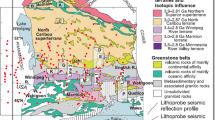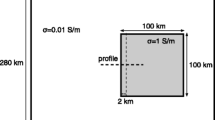Abstract
Computation of impedance tensor elements is one of the important steps in magnetotelluric data processing. Conventionally, the impedance tensor is defined as a 2 × 2 matrix with Zxx, Zxy, Zyx, and Zyy as elements. In the present study, the six-element impedance tensor is computed with a 2 × 3 matrix using Zxx, Zxy, Zyx, Zyy, Zxz, and Zyz. The properties of the impedance tensor elements have been analyzed for these above two types. The methodology has been tested with five component magnetotelluric data from the Kutch sedimentary basin, Gujarat, India. From the computation of apparent resistivity computation and phase we observed that there is small difference between the four and six impedance elements of Zxy and Zyx for most of the frequency band. However for longer period data, more than 100 sec, an increase in the apparent resistivity and decrease in the phase is observed. We also note that the tipper magnitude is nearly zero for most of the periods, but gradually shows an increasing trend for longer periods (>100 sec). The Kutch sedimentary basin geoelectric section shows near horizontal layers at shallow depths and anomalous high conductivity heterogeneous layers at deeper depths may be responsible for the large Hz component at longer periods. This indicates that the vertical component of the magnetic field, Hz, does play an important role in the estimation of electric field parameters in the region with large 2D/3D structures.
Similar content being viewed by others
References
Biswas, S.K., 2005, A review of structure and tectonics of kutch basin, western India, with special reference to earthquakes: Curr. Sci., 88, 1592–1600.
Cagniard, L., 1953, Basic theory of the magnetotelluric method of geophysical prospecting: Geophys., 18, 605–635.
Cantwell, T., 1960, Detection and analysis of lowfrequency magnetotelluric signals: Ph.D. thesis, MIT, USA.
Kaufman, A.A., and Keller, G.V., 1981, The Magnetotelluric Sounding Method: Elsevier, Amsterdam, p.457.
Sastry, R.S., Nagarajan, N., and Sarma, S.V.S., 2008, Electrical imaging of deep crustal features of Kutch, India: Geophys. Jour. Int., 172, 934–944.
Sims, W.E., F.X., Bostic, Jr., and H.W. Smith, 1971, The estimation of magnetotelluric impedance tensor elements from measured data: Geophysics, 36, 938–942.
Spies, B.R., and Eggers, D.W., 1986, The use and misuse of apparent resistivity in electromagneticmethods: Geophys., 51, 1462–1471.
Vozoff, K., 1972, The magnetotelluric method in the exploration of sedimentary basins: Geophys., 37, 98–141.
Vozoff, K., 1991, The magnetotelluric method, in Electromagnetic methods in applied geophysics: M.N. Nabighian, Ed., Society of Exploration Geophysicists, Tulsa, Oklahoma, vol. 2, part B, 641–711.
Wait, J.R., 1962, Theory of magnetotelluric fields; Journal of Research of the National Bureau of Standards, 66D, 509–541.
Wight, D. E., 1988, SEG MT/EMAP Data Interchange Standard: Society of Exploration Geophysicists.
Author information
Authors and Affiliations
Additional information
Shireesha M. joined as a Project Assistant in Magnetotellurics group (MTS) of National Geophysical Research Institute (NGRI) on November 1st, 2007 and working till date, also is a research scholar working for Ph.D on 3D modeling of magnetotelluric data in Magnetotellurics group (MTS) of National Geophysical Research Institute (NGRI). She is Presently working on 3D of magnetotelluric data.
Harinarayana T., Ph.D, Head, Magnetotellurics, National Geophysical Research Institute and presently the Director of GERMI-Gujarat Energy Research and Management Institute. His pioneering works are related to oil exploration, geothermal energy assessment, deep crustal studies, Tsunami studies, earthquake studies etc. He is an elected fellow of Indian Geophysical Union, Fellow of Andhra Pradesh Academy of Sciences.
Rights and permissions
About this article
Cite this article
Shireesha, M., Harinarayana, T. Processing of magnetotelluric data - a comparative study with 4 and 6 element impedance tensor elements. Appl. Geophys. 8, 285–292 (2011). https://doi.org/10.1007/s11770-011-0303-3
Received:
Revised:
Published:
Issue Date:
DOI: https://doi.org/10.1007/s11770-011-0303-3




